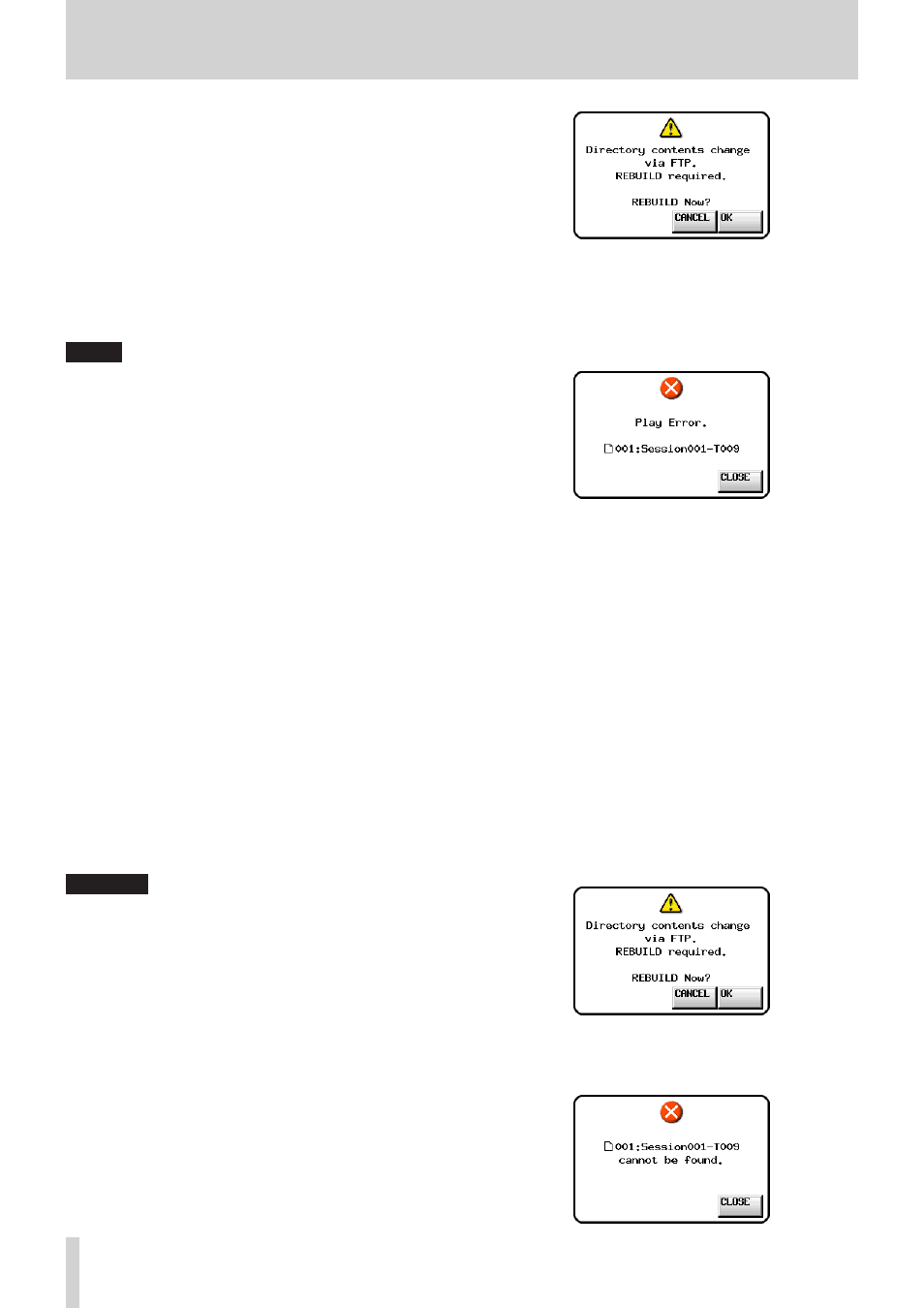13 – other functions – Teac HS-4000 User Manual
Page 126

126
TASCAM HS-4000
13 – Other functions
Required settings when connecting by FTP
The following settings are necessary when connecting to this
unit by FTP.
IP address:
This unit's IP address is shown in the IP
Address field of the REMOTE SETUP screen
ETHERNET page.
Port number: 21
User name:
HS-4000 (case sensitive, cannot be changed)
Password:
The default password is "HS-4000". The
password is case sensitive and can be
changed by using the Password Change
button on the REMOTE SETUP screen
ETHERNET page.
NOTE
• The number of simultaneous connections should be "1".
• Depending on the FTP client application, two simultaneous
connections with this unit might be possible, but files might
not be transferred correctly, so you should not use two or
more simultaneous FTP connections with this unit.
• FTP connections cannot be made when the EXT. CTRL item
has been set to LOCK on the LOCK SETUP screen. When an
FTP connection is active, setting this to LOCK will end the
connection.
• When an FTP connection is active, changing any settings
on the REMOTE SETUP screen ETHERNET page will end the
connection.
Working with files using an FTP client application
• Reading files from the unit
You can read files from this unit at any time.
• Adding new files to the unit
You can add new files to this unit at any time.
When recording, if you add BWF or WAV files to the current
session, they will be shown in the list with existing files,
recorded files and added files in that order.
• Overwriting existing files on the unit
You can only overwrite the current take when the unit is
stopped.
You cannot overwrite a take that is currently in use on the
playlist mode entry editing screen. You can overwrite other
existing files at any time.
However, if the PLAY SETUP screen GENERAL page Play
Mode item is set to All Take, overwriting the take following
the current take during playback might not be possible
depending on the timing.
CAUTION
• In playlist mode, if you overwrite a take that has been
added to a playlist as an entry, a “?” will be shown for the
corresponding entry on the ENTRY list and file ASSIGN
screens, and that file will be ignored for playback. To enable
playback of a file that has overwritten another, add the
overwritten file as an entry.
• In On-Air mode, if you overwrite a file shown on the on
air list screen, the corresponding take will be unchecked
and the file will be ignored for playback. Rebuild when the
following rebuild confirmation message is shown.
When you rebuild, all the takes will be enabled for playback
(checked), so deselect any that you do not want to be played
back.
• If overwriting causes the size, number of channels, bit-rate
or sampling frequency of an audio file to be different from
the previous file, inconsistencies could occur in the existing
timeline or playlist.
If such an inconsistency occurs, the following error message
might appear when you start playback.
Conduct the following to eliminate the inconsistency and
stop the error message from occurring.
Timeline mode: Erase the affected region.
Take mode: Delete the affected take from the CF card.
Playlist mode: Add the overwritten file as an entry.
On-air mode: Rebuild using the Home Screen pull-down
menu REBUILD button.
• Do not overwrite an existing audio file with a file that uses
a different sampling frequency. The inconformity will be
unresolvable.
3. Deleting files on the unit
The current take can be deleted only when the unit is
stopped.
Files other than the current take can be deleted at any time.
However, deleting files will cause inconsistencies between
the system files and audio files, so it is necessary to rebuild
after deleting a file.
• After deleting a file (and stopping playback or
recording), the following rebuild confirmation message
will appear. Touch OK to rebuild.
• If you do not rebuild, inconsistencies between the
system files and audio files will occur and a message like
the following might appear.
